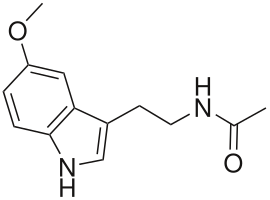멜라토닌: 두 판 사이의 차이
내용 삭제됨 내용 추가됨
편집 요약 없음 |
편집 요약 없음 |
||
| 17번째 줄: | 17번째 줄: | ||
== 각주 == |
== 각주 == |
||
| ⚫ | |||
{{각주}} |
{{각주}} |
||
== 참고문헌 == |
|||
* {{저널 인용 |vauthors=Wade AG, Ford I, Crawford G, McConnachie A, Nir T, Laudon M, Zisapel N | title = Nightly treatment of primary insomnia with prolonged release melatonin for 6 months: a randomized placebo controlled trial on age and endogenous melatonin as predictors of efficacy and safety | journal = BMC Med | volume = 8 | page = 51 | year = 2010 | pmid = 20712869 | pmc = 2933606 | doi = 10.1186/1741-7015-8-51 }} |
|||
== 바깥 고리 == |
|||
| ⚫ | |||
* {{언어고리|en}} [http://gmd.mpimp-golm.mpg.de/Spectrums/5c07b02a-6ada-4428-9a58-a739a3177f45.aspx Melatonin MS Spectrum] |
|||
* {{언어고리|en}} [http://tihkal.info/read.php?domain=tk&id=35 Melatonin entry in TiHKAL • info] |
|||
{{호르몬}} |
{{호르몬}} |
||
2016년 11월 4일 (금) 09:22 판

| |

| |
| 일반적인 성질 | |
|---|---|
| 화학식 | C13H16N2O2 |
| CAS 번호 | 73-31-4 |
| PubChem | 896 |
| ChemSpider | 872 |
| 물리적 성질 | |
| 분자량 | 232.278 g/mol |
| 열화학적 성질 | |
| 안전성 | |
멜라토닌(melatonin)은 짐승, 식물, 곰팡이, 박테리아에서 볼 수 있는 물질의 하나로, N-아세틸-5-메톡시 트립타민 화학식을 지닌다.[1] 짐승에게는 송과선에서 생성, 분비되며 광주기를 예측하는 호르몬이다.[2] 그러나 다른 생물체에게는 다른 기능으로 작용할 수 있다. 이와 비슷하게, 짐승의 멜라토닌 합성은 다른 생물과는 차이가 있다. 사람의 경우, 인체의 생체 리듬을 조절하고, 생식선 자극 호르몬의 분비를 억제한다.
짐승의 경우, 멜라토닌은 수면 타이밍, 혈압 조절, 계절에 따른 생식 등 생리적 기능의 활동일주기의 동기를 수반한다.[3]짐승에 미치는 멜라토닌의 생물학적 영향들 중 다수가 멜라토니 수용체의 활성화를 통해 이루어지지만,[4] 그 밖의 것들은 범발적이고 강력한 항산화물질 때문에 비롯된다.[5] (핵 및 미토콘드리아 DNA를 보호하는 특정한 역할과 함께)[6]
불면증을 위한 약으로 사용되지만, 이 부분에 효력이 있는지 과학적으로 충분히 입증되지 않았다.[7] 멜라토닌은 미국과 캐나다에서 일반의약품으로 판매된다. 다른 국가에서는 처방전이 필요할 수 있다.
역사
멜라토닌은 일부 양서류와 파충류들이 자신의 피부색을 바꾸는 구조와 관련하여 처음 발견되었다.[8][9] 1917년 초, Carey Pratt McCord와 Floyd P. Allen은 소에게 송과샘을 먹이면 어두운 표피 색소포를 축소시켜 피부가 빛이 나는 것을 발견했다.[10][11]
각주
- ↑ “Melatonin”. Sleepdex. 2011년 8월 17일에 확인함.
- ↑ Hardeland R, Pandi-Perumal SR, Cardinali DP (March 2006). “Melatonin”. 《The International Journal of Biochemistry & Cell Biology》 38 (3): 313–6. doi:10.1016/j.biocel.2005.08.020. PMID 16219483.
- ↑ Altun A, Ugur-Altun B (May 2007). “Melatonin: therapeutic and clinical utilization”. 《Int. J. Clin. Pract.》 61 (5): 835–45. doi:10.1111/j.1742-1241.2006.01191.x. PMID 17298593.
- ↑ Boutin JA, Audinot V, Ferry G, Delagrange P (August 2005). “Molecular tools to study melatonin pathways and actions”. 《Trends Pharmacol. Sci.》 26 (8): 412–19. doi:10.1016/j.tips.2005.06.006. PMID 15992934.
- ↑ Hardeland R (July 2005). “Antioxidative protection by melatonin: multiplicity of mechanisms from radical detoxification to radical avoidance”. 《Endocrine》 27 (2): 119–30. doi:10.1385/ENDO:27:2:119. PMID 16217125.
- ↑ Reiter RJ, Acuña-Castroviejo D, Tan DX, Burkhardt S (June 2001). “Free radical-mediated molecular damage. Mechanisms for the protective actions of melatonin in the central nervous system”. 《Ann. N. Y. Acad. Sci.》 939: 200–15. doi:10.1111/j.1749-6632.2001.tb03627.x. PMID 11462772.
- ↑ 인용 오류:
<ref>태그가 잘못되었습니다;Bra2015라는 이름을 가진 주석에 텍스트가 없습니다 - ↑ Filadelfi AM, Castrucci AM (May 1996). “Comparative aspects of the pineal/melatonin system of poikilothermic vertebrates”. 《J. Pineal Res.》 20 (4): 175–86. doi:10.1111/j.1600-079X.1996.tb00256.x. PMID 8836950.
- ↑ Sugden D, Davidson K, Hough KA, Teh MT (October 2004). “Melatonin, melatonin receptors and melanophores: a moving story”. 《Pigment Cell Res.》 17 (5): 454–60. doi:10.1111/j.1600-0749.2004.00185.x. PMID 15357831.
- ↑ Coates PM, Blackman MR, Cragg GM, LevineM, Moss J, White JD (2005). 《Encyclopedia of dietary supplements》. New York, N.Y: Marcel Dekker. 457–66쪽. ISBN 0-8247-5504-9.
- ↑ McCord CP, Allen FP (January 1917). “Evidences associating pineal gland function with alterations in pigmentation”. 《J Exptl Zool》 23 (1): 206–24. doi:10.1002/jez.1400230108.
참고문헌
- Wade AG, Ford I, Crawford G, McConnachie A, Nir T, Laudon M, Zisapel N (2010). “Nightly treatment of primary insomnia with prolonged release melatonin for 6 months: a randomized placebo controlled trial on age and endogenous melatonin as predictors of efficacy and safety”. 《BMC Med》 8: 51. doi:10.1186/1741-7015-8-51. PMC 2933606. PMID 20712869.
바깥 고리
| 이 글은 생화학에 관한 토막글입니다. 여러분의 지식으로 알차게 문서를 완성해 갑시다. |
